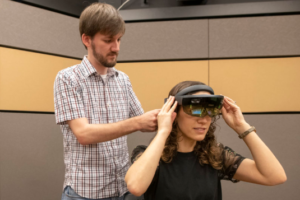Five reasons why smart glasses mean business

v
“Someday augmented reality will become a mainstream feature of ordinary eyeglasses and sunglasses for everyday, general-purpose consumer use. But that day is many years in the future.
Reading the news, it’s easy to conclude that consumer smart glasses are on the brink of becoming available.
Apple is famously toiling away on future iGlasses. A recently published “continuation patent” (which is a patent that the company wants the Patent Office to keep examining to change the scope of the original patent) describes what Apple calls “data glasses” capable of integrating virtual content with the real world, including for StreetView-style turn-by-turn directions and other location-based applications.
The patent office recently published several new smart glasses patents for Apple. One reveals new technology Apple is working on for holographic display of objects in glasses.
Facebook’s “Reality Labs” has been working on augmented reality glasses for a few years. A patent filed this week by Facebook describes a “cartilage conduction audio system for eyewear devices” that would project sound into the ear without blocking ambient sounds.
And Facebook CEO Mark Zuckerberg was spotted this month visiting the headquarters of Luxottica, which is a global eyeglass giant known to be interested in partnering with smart glasses makers.
These projects by Apple and Facebook won’t ship as consumer products for many years. The technology simply isn’t ready.
The article (in full here) explores why smart glasses are a non starter for consumers, citing 5 reasons:
- They are socially unacceptable (interesting discussion on technical features and use cases in enterprise)
- Solve business problems not consumer problems. Companies mentioned include Boeing, DHL, Airbus, medicine are all discussed.
- Often need tethering. Many new enterprise and business products have to be tethered to a computer that’s more powerful than puny ones that can be comfortably attached to the wearer’s head.
- Don’t have all day battery life
- Are too expensive








